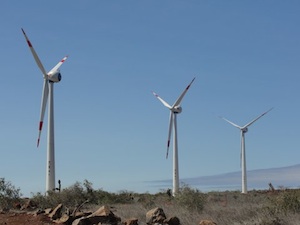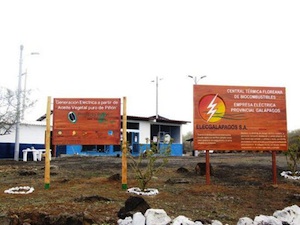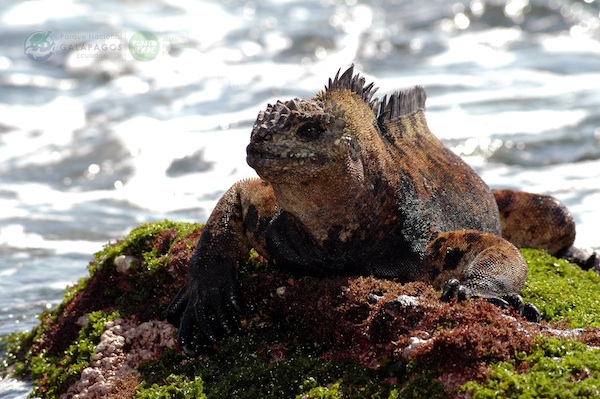Zero fossil fuels on the Galapagos Islands
Situated in the Pacific Ocean some 1,000 km from the South American continent, these 19 islands and the surrounding marine reserve have been called a unique ‘living museum and showcase of evolution’. The Galapagos Islands, officially called Archipiélago de Colón, were inscribed on the World Heritage List in 1978 and declared a Biosphere Reserve in 1984.
En 2007, the government of Ecuador launched the “Zero fossil fuels on the Galapagos Islands” initiative, planning to phase out the consumption of fossil fuels at the Galápagos Islands by the year 2015. During these years, a diverse range of projects on the use of different energy sources (wind power, solar PV, and biofuels), have gradually been developed, including actions related to energy efficiency and training.
The ERGAL project (Energías Renovables para Galápagos) coordinates the implementation of renewable energy projects at the archipelago of Galápagos. These projects contribute to the Government Zero Fossil Fuels for the Galápagos Initiative executed by the Ministry of Electricity and Renewable Energy, and rely on the support of UNDP and the Global Environmental Facility (GEF).
The Observatory of renewable energies in Latin America
The Galapagos experience is based on a wide range of projects in different parts of the archipelago that are paving the way towards energy self sufficiency.
Renewable Energy will gradually phase out fossil fuels in the electricity generation of Santa Cruz/Baltra and will gradually replace gasoline utilization in the transport sector. The Baltra wind farm (2.25 MW) Photo Gallery, which has the highest energy demand within the Galapagos Archipelago.The country’s first large-scale wind project (2.4 MW) was funded and implemented by the Global Sustainable Electricity Partnership. In operation since 2007 on the island of San Cristobal, it meets nearly a third of the electricity demand of the island.
Another dimension of the project regards the use of solar energy (fotovoltaica) to replace diesel consumption at the islands of Isabela and Floreana, and to complement wind energy contribution in the Santa Cruz/Baltra system.
The initial project on Floreana was funded by the Spanish Agency for International Cooperation, the Galapagos National Park, the local Council of Floreana, and ERGAL. After its launch in 2004, the reported fuel saving has been of 35%.
Photo Gallery 3.3 MW. Además, in cooperation with BMZ, a PV power plant of 1.1MW is being developed, the Abertis Foundation 100 % and the Spanish Network 1.2 MW (UNESCO School in South East Europe represents a unique educational opportunity to enhance capacity-building in sustainable energy by conveying in a single venue a substantial capital of knowledge) Green energy to light a World Heritage site Virunga National Park’s first hydropower plant has started to generate electricity, y 0.9 Most residents in the area currently rely on dirty and.
News Archives (piñón) to fuel small diesel generators on the islands. The“piñon oil energy program” has been so successful on Floreana that they are considering expanding it to the town of Puerto Villamil on the island of Isabela. It relies on the support of the Deutsche Gesellschaft für Internationale Zusammenarbeit (GIZ) GmbH
Photo Gallery.
Lessons learned and replicability
the Abertis Foundation, and the Spanish Network.
UNESCO School in South East Europe represents a unique educational opportunity to enhance capacity-building in sustainable energy by conveying in a single venue a substantial capital of knowledge (Green energy to light a World Heritage site Virunga National Park’s first hydropower plant has started to generate electricity, Most residents in the area currently rely on dirty and, News Archives, Isabela) Photo Gallery (renovable) energy technologies in the whole country and, eventually, in the region. In this sense, the project is conceptualised as a laboratory for testing different alternative options for renewable energy technologies like wind/ PV/ biofuels.
the Abertis Foundation, agencias, and the Spanish Network. UNESCO School in South East Europe represents a unique educational opportunity to enhance capacity-building in sustainable energy by conveying in a single venue a substantial capital of knowledge, Green energy to light a World Heritage site Virunga National Park’s first hydropower plant has started to generate electricity, Most residents in the area currently rely on dirty and. Finalmente, News Archives.


















